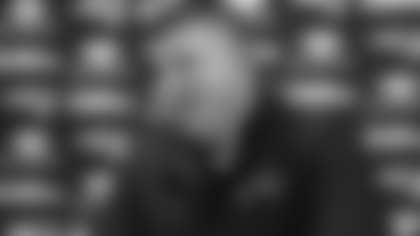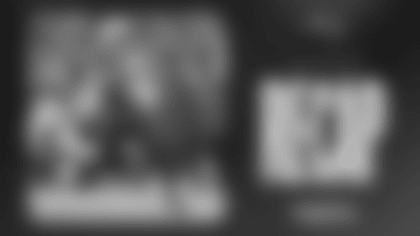BB: I'll give a quick update on where we're at here. So, we're on the fifth day here. This is really Phase One for us, so meetings and a total of an hour walkthrough on the field today. It goes to an hour and 15 minutes. And then the players are running and lifting and doing things like that, not on their own but with the strength coaches, not with the football coaches. So, a lot of meeting time, time to get back into some physical activity and training, which is good but really we're still another four days of this before we start to move into Phase Two, and then a couple days of Phase Two and then a couple days of Phase Three. And then as Stacey [James] said, then we get to the 17th. So, moving along. The pace is what's been set up, so I think it's good and the players are transitioning to a higher gear and higher volume and more intensity on a basis that's probably good for training. So, we're following that and we're kind of halfway through this first process.
Q: How would you best describe what it's like for you working and managing what is a very unpredictable situation this year? How much flexibility does it demand, and how much does your unique experience as a head coach give you the ability to do that?
BB: Yeah, well, we'll just take it as it comes. Each step of the way I think may be a little bit different and require a little bit of thought and possibly creativity. Again, for right now, we're basically in a Phase One situation or environment. That's what we're doing. We're doing basically what we're doing in Phase One, with, as I said, a few modifications. So, it's fine, we're being productive, we're using the time that we have to definitely make strides, but there are some things we can't do. But we're not going to focus on those. We're going to look to the things we can do and make the most out of those. I think the players, the coaches and the entire organization has done a good job of that.
Q: Obviously, the pandemic is larger than football. For you, was there any consideration about potentially not coaching this year or were you always determined to coach through this?
BB: I feel very good about the environment that we're in. So, I feel fine.
Q: Did anyone on your staff opt out?
BB: No.
Q: Is the idea of putting a quarterback in quarantine this year something you're considering with that or any other position on the team?
BB: Yeah, I'd say as always, Ben [Volin], we'll try to look at our options and do what we feel is best for the football team. So, that's what we'll continue to do.
Q: You haven't decided yet if you would do that?
BB: As I said, we're in Phase One. We're proceeding in Phase One. I can't speak for everybody, but I think my impression is as an organization, as a coaching staff, the support people, the players, there's a comfort level with what we're doing and who's doing it and how we're doing it, and we're being productive. If concerns or problems come up, then we'll address those, but for right now, I think it's a good working environment, we're getting a lot done and the organization has taken a lot of steps to ensure everyone's safety and opportunity to do their job and do it safely and do it productively. Certainly, there is a lot of responsibility on each one of us to do things in a way that don't affect others negatively, that we take the precautions that we can and should, so that's what we're doing.
Q: How has Cam Newton come to grasp the playbook in terms of the things you have installed so far?
BB: Well, as I said, we're in Phase One. We're presenting a lot of information, going through films and we have a daily walk through and that's about it. Again, as I said, the restart of football is going at a slow pace right now. The training is ahead of the football, so that's what we're doing.
Q: In terms of his physical health and training, has he been up to speed and able to participate in everything so far?
BB: Well, again, the coaches aren't on the field for the training part of the program, so I couldn't really comment on that. Our strength coaches supervise that. And the walk-throughs are the walk-throughs – they're walk-throughs.
Q: This is a different preseason and training camp. Have you and the coaches talked about having to narrow the scope of what you focus on so that when you do get on the field, your execution will be what you want during the season?
BB: Again, I wouldn't characterize our preparations as there are things that we can't do. Again, pretty much everything that we're doing is what we do do. The setup is a little bit different, but we do Phase One, we do Phase Two, we do Phase Three, we do training camp, we do padded practices, we do practices in shells, we do walk-throughs in training camp. We'll be doing all those things, as we normally do. We won't be playing preseason games, so that will definitely be one thing that we'll need to prepare for differently than we prepared for in the past. We won't be able to have those same kind of game experiences that preseason games provide, but everything else is the same. It's at a modified pace or schedule, but the drills themselves and the sequence of those are essentially what they've been, it's just done in a different time frame and it's done over a six to seven week period instead of the three days a week in the spring and then the four days a week at the end, then a training camp period. Again, this is what every college team does. Every college team goes to training camp, whatever it is, three weeks, three-and-a-half weeks before their first game. And essentially, after we get past [these phases], when you start at the 17th, that puts us about in that four week period until the first regular season game. One of those weeks would be preparation for the opener. So, it's very similar to what the college programs have always done and what they're doing now. We just have to modify what we do to be more similar or try to replicate it to a degree to what college teams do every single year.
Q: One of the great things to watch in training camp is you coaching hands-on and making corrections with the players. In this situation, will you have to restrict yourself at all or go about things in a different way?
BB: I guess we'll see. Yesterday was the first day that we had a walk-through with both the offense and the defense on the field at the same time. Prior to yesterday, we were defense against defense, offense against offense. So, yesterday was our first chance to do that. I would say it looked to me like all the coaches coached and players played pretty much like we always do, other than masks and some other modifications, things like that. But, no, I didn't see any substantial difference, no.
Q: When you were holding virtual meetings all offseason, did you do anything unique to keep players engaged or combat Webex fatigue?
BB: Yeah, definitely. We talked about that a lot. After about two meetings, we could see that that was going to be the new way of the world. A decent amount of the staff meetings was dedicated to that, especially early. Coaches, we had a lot of individual meetings. Our team meetings were more limited because, I would say, just the quality of having a meeting with 60 or 90 people, as opposed to having it with four or five. The engagement is a lot higher, the interaction is a lot better, the mute button doesn't have to be off when you have 100 people on the meeting and so forth. Anyway, we learned a lot about those virtual meetings and we definitely did a lot of things to try to heighten the engagement, set up some competitive things, set up a variety of things, and then the coaches exchanged ideas. One coach would say, 'Hey, we did this,' and then maybe another coach would pick up on that idea and do it in a way that fit his room or his position. We might have a competition between the two rooms on a certain thing and let them compete against each other and see who's better at whatever the activity was that was structured. I talked to a number of college coaches. They were, in a lot of cases, ahead of us on this because of spring ball. So, they had their spring practice virtual meetings prior to the start of our offseason program, which I want to say was like mid-April. A lot of those teams were doing the same things that we were doing in terms of virtual meetings as early as the first of March. Some of those people had great suggestions: 'This really worked well for our team and our guys loved this,' or 'We tried this and it didn't work so well. Here's the problems with it. It sounds good, but it didn't go over that well.' There was a lot of that. Our coaches talked to, like I said, several other college coaches and programs, and then we exchanged ideas. It was very educational for all of us to try to do that. Some activities worked better than others, and each coach kind of had to get a feel for his players, their level of excitement to do certain things might not have matched a similar concept or game or whatever it was. I'd say we modified our teaching and the interactions, some of the games, some of the competitions, things like that that we did over the course of the spring. Followed up a little bit on those the first week that we came back – I think it was the 28th [of July] or whatever it was when everybody was still quarantined on the testing – so we were able to continue that from the spring. Yeah, I mean, long answer to a short question there, but yes, we did it on a number of different levels. We learned a lot as we went along. The players were responsive, productive. They certainly gave us a lot of good feedback, too. You know, a lot of those guys are a lot more tech savvy and had some good ideas way ahead of some of the people on the coaching staff, particularly myself – I'd probably be on the bottom of that tech list – and we used some of their ideas, as well. Collectively, I thought things went better than I thought they were going to go, to tell you the truth. I thought they went pretty good. We followed up on it. Going forward, it might be something that I probably would have never even considered a year ago. Now, after having a pretty significant amount of experience with it, I could see where there might be a place for it in the future. That's kind of where we are on it. Thank you for the question.
Q: Do you feel at all a different level of energy coming back for training camp after having to be away for so long? How did the change in your football calendar impact you?
BB: Yeah, well, I think we've spoken about this before. I think in a lot of respects, this is similar to 2011. In many respects, it's different. But in terms of not seeing the players until training camp, it's similar. We certainly had a lot more interaction with the players this year than we did during the lockout season. And then we had the preseason games in that season that we're not going to have in this season, so there are definitely differences, but there are some similarities in some of the coaches and players that were here at that time. We've reflected on that. I think there were some things that we learned from that year that have application. Again, there's other things that don't. Each year is different. This year, the ramp up pace instead of being during the spring and then taking a break and then coming back to training camp is all taking place in one sequence without a break, essentially, and that's a little bit different, but I think it will work. I think the players will be prepared physically and mentally to play football, assuming the conditions stay similar to what they are now. I think we've seen that it's been almost two weeks that we've been from virtual to Phase One, to now we're starting to ease into a little bit of a higher Phase One, which will lead into Phase Two. So, I think the progression is logical. I think it's working. We've got a long way to go and we have quite a bit of time before the opening game. Hopefully, we'll be in a competitive position at that point, and I'm sure that we'll continue to improve as a team, like we always do, in the first several weeks of the season. But again, that's the way it always is. The 80-man roster, we've dealt with that before, although not recently. So, I think when you put it all together, we have and we will find a way to make it work and we'll try to make it as effective as we can.
Q: Now that you and the players are back in the building, what's been the biggest adjustment that you and your staff have had to make due to COVID-19 regulations and the stadium's new setup?
BB: Honestly, I wouldn't say any of it has just been overwhelming. We wear masks. There's not a buffet line for food; the food is ordered. It's boxed and packaged. The dining staff have done a great job. The meetings are in bigger rooms. We're more spread out. But, essentially, it's the same meeting, we're just distanced and wearing masks. I think everybody's just a little more conscious of the hand washing, the sanitizing, the distancing, we wear monitors and all that. There's just a higher awareness of it, but I mean, fundamentally, we're still going over the same material in a similar progression. We have walk-throughs, we have meetings, we have training and conditioning. We're going to eventually have individual drills when we get to Phase Two, and then we're going to get to Phase Three and have 11-on-11 drills. I don't think it's monumental, but certainly there are adjustments, none of which are I would say particularly inhibiting. It's a little bit different, maybe a little bit more time consuming and just more precautionary, but I think we've tried to address everything. And we've asked the players – and they've been great – we've asked the players for their input. If they see something that looks like it needs to be adjusted or corrected or whatever, they're good to bring it up and then we take a look at it and do what we can to whatever the situation is, try to improve it. We're very fortunate here. We have a stadium; we have a big facility. I know there are other teams that are dealing in a much smaller training facility. We have a lot of big spaces and open space that we can work with, and that's very helpful in the environment that we're in. We have great food service and a big training room and weight room and so forth. So, we're able to accommodate with the visitor's locker room – when you add that in – we're able to accommodate I think 80 people pretty comfortably. Of course, we have some plexiglass and things like that up that take things a step further, but we're able to handle the number of people and what we would normally do. It's been pretty effective. Again, we're not walking across the hall to a meeting. We're walking maybe down the end of the tunnel to it, but to me, those are relatively minor things. I'd say overall, we're doing things pretty close to the way we normally do them with, as I said, more masks, more plexiglass for sure. I don't know what the plexiglass bill around here is, but it's got to be pretty high.




































